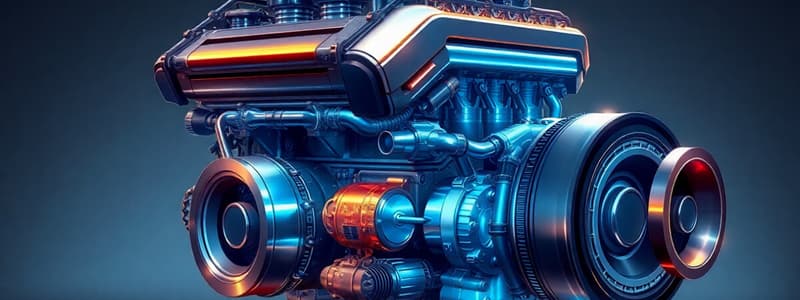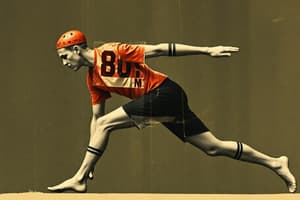Podcast
Questions and Answers
In an in-line engine, what is the primary limitation to increasing the number of cylinders beyond six?
In an in-line engine, what is the primary limitation to increasing the number of cylinders beyond six?
Difficulty in cooling the rear cylinders and the increased length of the crankshaft.
Describe how the camshaft is driven and its function in relation to the valves in an in-line engine.
Describe how the camshaft is driven and its function in relation to the valves in an in-line engine.
The camshaft is driven from the crankshaft at half engine speed and operates the valves using push rods and rockers.
Explain why V-type engines offer a weight reduction compared to in-line engines.
Explain why V-type engines offer a weight reduction compared to in-line engines.
V-type engines allow two sets of connecting rods to operate on the same crankpin.
What is the significance of arranging the throws of a six-cylinder engine's crankshaft at 120-degree intervals?
What is the significance of arranging the throws of a six-cylinder engine's crankshaft at 120-degree intervals?
How does the arrangement of cylinders in a horizontally opposed engine contribute to its balance?
How does the arrangement of cylinders in a horizontally opposed engine contribute to its balance?
Describe the intake process (Process 1-2) of the Otto cycle.
Describe the intake process (Process 1-2) of the Otto cycle.
In the context of horizontally opposed engines, what is a common method used to minimize the engine's length, particularly in four-cylinder configurations?
In the context of horizontally opposed engines, what is a common method used to minimize the engine's length, particularly in four-cylinder configurations?
Explain the 'blow down' process (Process 5-6) in the Otto cycle and its purpose.
Explain the 'blow down' process (Process 5-6) in the Otto cycle and its purpose.
What advantage does an 'inverted V-type' engine configuration offer, and under what condition is it typically used?
What advantage does an 'inverted V-type' engine configuration offer, and under what condition is it typically used?
In a six-cylinder horizontally opposed engine, if some inlet valve cams are shared by opposite cylinders, what is the total number of cams on the camshaft?
In a six-cylinder horizontally opposed engine, if some inlet valve cams are shared by opposite cylinders, what is the total number of cams on the camshaft?
Flashcards
In-Line Engine
In-Line Engine
Cylinders arranged in an upright or inverted row along the crankcase.
Horizontally Opposed Engine
Horizontally Opposed Engine
Cylinders arranged in horizontal banks on opposite sides of the crankcase.
V-Type Engine
V-Type Engine
Cylinders arranged in two rows or banks forming a V-shape.
Otto Cycle
Otto Cycle
Signup and view all the flashcards
Otto Cycle: Intake (1-2)
Otto Cycle: Intake (1-2)
Signup and view all the flashcards
Otto Cycle: Compression (2-3)
Otto Cycle: Compression (2-3)
Signup and view all the flashcards
Otto Cycle: Combustion (3-4)
Otto Cycle: Combustion (3-4)
Signup and view all the flashcards
Otto Cycle: Expansion (4-5)
Otto Cycle: Expansion (4-5)
Signup and view all the flashcards
Otto Cycle: Blow down (5-6)
Otto Cycle: Blow down (5-6)
Signup and view all the flashcards
Study Notes
In-Line Engine
- Typically has four or six cylinders in an upright or inverted arrangement along the crankcase.
- Having more than six cylinders is rare due to cooling challenges for rear cylinders and the required crankshaft length.
- In a four-cylinder engine, four power strokes occur every two crankshaft revolutions.
- Firing orders like 1,3,4,2 or 1,2,4,3 help ensure smooth operation.
- A camshaft, driven at half engine speed, operates the valves using push rods and rockers.
- The eight cams (two per cylinder) open/close intake/exhaust valves based on firing order and valve timing.
- In a six-cylinder engine, six power strokes happen every two crankshaft revolutions.
- Each cylinder fires every 120º of crankshaft movement.
- Crankshafts with throws (offset portions containing crankpins) are arranged accordingly.
- The camshaft, driven at half engine speed, has suitably arranged cams.
- A typical six-cylinder engine firing order is 1,4,2,6,3,5, but alternative orders exist with different crankshaft designs.
Horizontally Opposed Engines
- Cylinders (usually four or six) are arranged horizontally on opposite sides of the crankcase.
- Engines typically have individual connecting rods on separate crankpins, creating staggered cylinders.
- A single camshaft, above or below the crankshaft, drives valves in both cylinder banks at half engine speed.
- Inlet valve cams may be shared by opposite cylinders.
- A six-cylinder engine can have nine cams: six exhaust cams and three shared inlet cams.
- To shorten the engine, a four-cylinder has three crankshaft bearings, while a six-cylinder has four.
- In a six-cylinder engine, throws are arranged at 120° intervals due to six firing strokes per two crankshaft revolutions.
- The normal firing order for a six-cylinder engine is 1,4,5,2,3,6, but different orders are possible.
V-Type Engine
- Cylinders are arranged in two rows or banks, forming a V-shape at a 90, 60, or 45-degree angle.
- These engines always have an even number of cylinders in each row.
- Two sets of connecting rods operate on the same crankpin because the cylinder banks are opposite.
- This design reduces weight compared to in-line engines.
- The frontal area is only slightly larger than in-line engines, allowing for streamlined engine cowlings.
- If cylinders are above the crankshaft it's an upright V-type, when below, it's an inverted V-type
- Inverted designs allow for better pilot visibility.
Otto Cycle
- The Otto cycle is the standard cycle for spark-ignition (SI) internal combustion engines.
Otto Cycle Processes
- Process 1-2 (Intake): Inlet valve opens, the piston moves to admit fuel-air mixture at constant pressure.
- Process 2-3 (Compression): Valves are closed, the piston compresses the mixture to minimum volume.
- Process 3-4 (Combustion): Spark ignites the mixture, causing combustion, increasing temperature and pressure.
- Process 4-5 (Expansion): Combustion products do work on the piston, decreasing pressure and temperature.
- Process 5-6 (Blow Down): Exhaust valve opens, dropping the pressure.
Studying That Suits You
Use AI to generate personalized quizzes and flashcards to suit your learning preferences.




